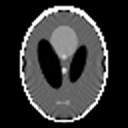
Backprojection

![]()
 |
Backprojection
|
Backprojection project is supported by Mecury Computer Systems, Inc.
| Professor Miriam Leeser | Northeastern University, Associate Professor |
| Professor Eric Miller | Northeastern University, Associate Professor |
| Marc Trepanier | Mecury Computer System, Product Planning System Engineer |
| Srdjan Coric | Northeastern University, Graduate Student |
| Haiqian Yu | Northeastern University, Graduate Student |
Implement backprojection in reconfigurable hardware.
Backprojection is the most common algorithm used in the tomographic reconstruction of a clinical data. An everyday example of tomographic is the medical x-ray CAT scan: a person is x-rayed from various angles and the two-dimensional density of the person can be "reconstructed" by using backprojection. However, the restoration is computation consuming. Our goal is using hardware to implement backprojection algorithm thus greatly decrease the processing time.
For more information about backprojection & tomography, see Here.
Phase I:
Annapolis Wildstar with 3 Xilinx Virtex FPGA Processing Element-XCV1000 and 40 Mbyte of Synchronous ZBT SRAM
Phase II:
Annapolis Firebird
with Xilinx Virtex
FPGA Processing Elements-XCV2000E and 32Mbyte of Synchronous ZBT SRAM.
Basically, what we do here is to accumulate the corresponding backprojection
value of different angle for each pixel. The detailed algorithm can be
found here.
Click Here for the hardware data flow
Simple architecture & Advanced architecture using Wildstar (Finished)
Simple
architecutre & Advanced architecutre using Firebird (Current)
Backprojection result: Software floating point vs. Hardware fixed point
S. Coric, M. Leeser, E. Miller, M. Trepanier, "Parallel-Beam Backprojection:
An FPGA Implementation Optimized for Medical Imaging", Tenth ACM Int.
Symposium on FPGA, Monterey, CA, USA. Feb.24-26, 2002